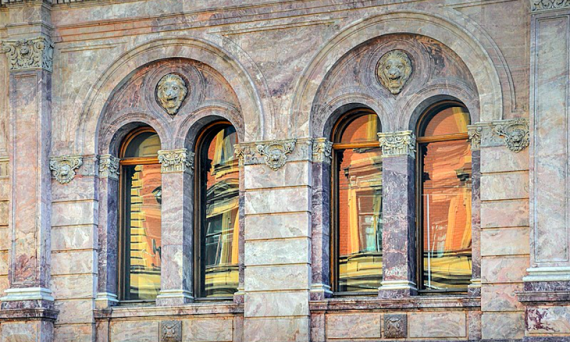 Christian Toson, EUSP alumnus, just published an interesting article in the 'Prospekt magazine' about the history of the EUSP building - beautiful Small Marble Palace:
Christian Toson, EUSP alumnus, just published an interesting article in the 'Prospekt magazine' about the history of the EUSP building - beautiful Small Marble Palace:
It is difficult not to notice the Kushelev-Bezborodko Palace when walking along Gagarinskaya street. Its pink and grey marble facade, finely sculpted double-arched windows, and decorative lions with Italian motifs, combine for a unique piece in the great architectural ensemble of St Petersburg. Despite the city’s rich heritage, the number of marble-clad buildings here can be counted on the fingers of one hand—almost all of them big public buildings or churches, making the Small Marble Palace all the more remarkable.
The building was founded in 1858, when brothers Grigori and Nicolai Alexandrovich Kusheleev-Bezborodko decided to improve their assets on Gagarinskaya street. They called Edward Jacobich Schmidt (1822-1880), a designer from a protestant family in Württemberg and a naturalised Russian. As an architect, his education took place at the St Petersburg Academy of Fine Arts and was completed in a series of travels in Italy. Schmidt was connected to the Kushelevs through family relations and designed the building according to their caprices and the desire for luxury, thus combining a wide variety of styles in the different parts of the palace: a Neo-Renaissance facade, a couple of Louis XIV parlours, a Rococo chamber, a 19th century glass-and-iron orangerie, a library, and many other minor ambients and supplies.
We cannot place Schmidt among the great talents of architecture in his period, nonetheless, the palace he projected is one of the most unique masterpieces in St Petersburg. It is not always the case that a genius is needed to create a great artwork, especially when a great number of actors are involved in its realisation.
The original project of Schmidt was intended to be completed in traditional stucco, but exceptional circumstances allowed the Kushelevs to clad their facade with marble. In fact, in 1858 the long and expensive construction of St Isaac Cathedral was completed, and suddenly construction materials—high-quality marble and specialised labour coming from that working site—became relatively cheap. The Kusheleves seized the opportunity and built a small palace, as luxurious as a royal residence. In fact, after them, members of the highest aristocracy would continue to live in the building.
The palace came out so luxurious that after ten years, the Grand Duke Konstantin Nikolayevich (also the owner of the “big” Marble Palace) bought it for his son Nikolai Konstantinovich in 1873, who would become famous in Petersburg’s high society for his Casanova-style of life. In fact, the palace was the stage of one of the most claimed scandals of the time. Nikolai Konstantinovich fell in love so deeply with the American ballerina Fanny Lear (aka Hattie Blackford), that he forsook his family, getting to the point of stealing the family’s gems, a crime for which he was exiled to Tashkent.
Then, from 1880 to 1913, the building became the residence of Ekaterina Dolgorukaya, the lover and morganatic wife of Tsar Alexander II. She was also an outsider to the Royal family, but she loved the Tsar so much that after his assassination, she remained in mourning for her husband and built a small memorial museum in his honour on the first floor. Some memoirs state that at the stairs of the main entrance, there was a real stuffed bear that greeted visitors with the inscription “Lisino. Killed by his Imperial Majesty near the Lisinski school forestries on 22 January 1875 year.”
After that, the palace was no longer a noble residence. It quickly passed from a rich merchant to the Soviet state, when it was a dance school and then the Research Institute for Labour. Since 1994, it has served as the headquarters of the European University, which has planned a big renovation project for the interiors, which have become rather decrepit since the Soviet period. However, currently, the future of the building is uncertain, due to the difficult legal situation surrounding the european University.
Read more at www.prospektmag.com
